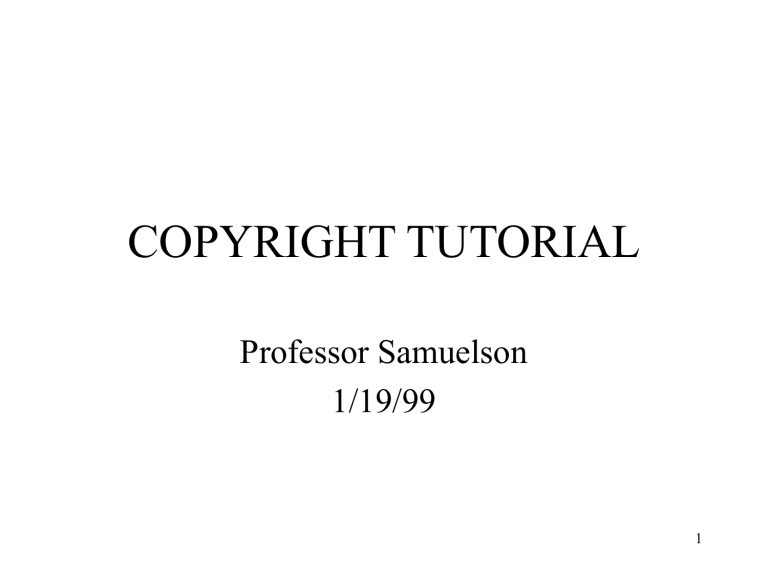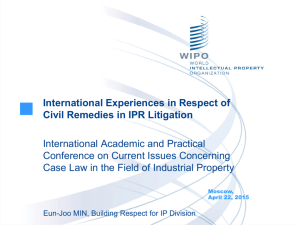- UC Berkeley School of Information

COPYRIGHT TUTORIAL
Professor Samuelson
1/19/99
1
WHAT IS “IP”?
• Intangible rights in intangible information
• Patents for technological inventions
• Trade secrets for commercially valuable secrets (e.g., source code, Coke formula)
• Trademarks (e.g., Coke) to protect consumers against confusion
• Rights of publicity (e.g., Elvis heirs cf. imitators)
2
DIFFERENT THEORIES
• Utilitarian (e.g., grant rights to create incentives for beneficial investments)
• Natural rights (e.g., persons have natural rights in their creations if valuable)
• Personality-based (e.g., my creation is an extension of myself)
• Unjust enrichment (e.g., others ought not be unjustly enriched by appropriating ideas)
3
U.S. CONSTITUTION
• Congress empowered to promote progress of science and useful arts
• by securing to authors and inventors
• exclusive rights
• for limited times
• in their respective writings and discoveries
4
CONTOURS FROM CONST.
• Purpose: promote science
• Who: authors
• How: exclusive rights
• How long: limited times
• For what: writings
• Other constitutional provisions of note: supremacy clause, 1st A, commerce clause
5
SUBJECT MATTER OF COP.
• “Original” works of authorship (Feist: white pages listings not “original”)
• “Fixed” in a tangible medium of expression
(MAI: RAM copy fixed enough to infringe)
• Categories of works: literary works, musical, dramatic, pictorial and sculptural, architectural, audiovisual, sound recordings, choreographic
6
MULTIPLE COPYRIGHTS
• Think of a typical music CD which has:
• Music
• Lyrics
• Sound recording
• Photograph or drawing or both on cover
• Explanatory text about recording artist
• Rights clearances a complicated process
7
“UNCOPYRIGHTABLE”
STUFF
• Ledger sheets and blank forms
• Rules and recipes (“merger”)
• White pages listings of telephone directories
• Facts and theories
• Ideas and principles
• Methods of operation/processes
• Bicycles and bicycle racks
8
COMPILATIONS &
DERIVATIVE WORKS
• Originality in selection and arrangement of data elements = prot’ble compilation
• Original expression added to derivative as cf. underlying work = prot’ble d.w.
• Copyright doesn’t extend to preexisting material (e.g., data or public domain play)
• Use of infringing materials will
9
WHO OWNS?
• The creator of the work (“author”)
• But “work for hire” rule means employer is
“author” of employees’ work
• Commissioning party generally does not own copyright; special rules
• Jointly authored works: contribution of expression w/ intent to make part of inseparable whole
10
HOW AUTHORS GET RIGHTS
• Attach automatically by operation of law from first fixation
• Last for life of author plus 70 years (or 95 years from publication for corporate works)
• Register with Copyright Office to ensure broadest remedies and to bring suit
• Publication not required, but once work is published, deposit with LOC may be
11
WHAT OWNER OWNS
• Exclusive rights to reproduce work in copies,
• to prepare derivative works,
• to distribute copies to the public,
• to publicly perform and display work
• “Moral rights” for works of visual art
• Secondary infringements (e.g., facilitating others knowing they’ll infringe)
12
HOW AUTHORS EXPLOIT
RIGHTS
• License rights to others on exclusive or nonexclusive basis
• Sell (“assign”) rights to others (e.g., publisher)
• Develop products yourself
• Join copyright collective (e.g., ASCAP) so that they can do licensing for you
• Sue people who exploit without permission
13
LIMITS ON EXCLUSIVE RTS
• Fair use (e.g., Sony Betamax, Acuff-Rose)
• First sale (e.g., libraries, bookstores)
• Library-archive (e.g., ILL, course reserves)
• Classroom performances
• Small operations (e.g., radio in fast food joint)
• Specialized inter-industry compulsory licenses (e.g., cable-network TV)
14
FAIR USE & PUBLIC DOMAIN
• People make fair uses all the time (e.g., photocopy Dilbert cartoon or news article)
• Fair use depends on multiple factors, including the potential to harm markets
• Fair use sometimes important for democratic discourse (e.g., parody of politician’s speech)
• Public domain = reservoir from which authors can draw (e.g., Shakespeare) 15
DIGITAL COMPLICATIONS
• Digitized photographs of public domain works (e.g., Microsoft claims ownership)
• Colorization of movies (e.g., what if it results from automation?)
• Databases (e.g., very easy to steal the data and leave the base)
• NBA v. Motorola (“stealing” data on NBA games for sports pager)
16
DIGITAL COMPLICATIONS--2
• In digital form, all works are literary works
• Can’t access or use digital information without making copies
• Very cheap and easy to make multiple copies and disseminate via networks
• Very easy to digitally manipulate w/o detection
• People expect it to be free or nearly so
17
WHITE PAPER ON IP & NII
• Full potential of NII won’t be realized unless IP/copyright owners are adequately protected
• Many are withholding works from the ‘net because of threat of piracy
• Copyright can be adapted to digital environment, need a few changes
18
WHITE PAPER ISSUES
• Temporary copies in RAM (reading or browsing as infringement?)
• No more fair use (if can be licensed, must be licensed; object to fair use “tax”)
• No more first sale/sharing rights (first sale only permits redistributing same copy, not making new ones)
• OSP strict liability for user infringements
19
WHITE PAPER ISSUES--2
• Tampering with copyright management information should be illegal
• Need to outlaw circumvention of technical protection systems
• Need to outlaw manufacture or distribution of circumvention technologies
• Get int’l treaty to universalize these new norms
20
WIPO COPYRIGHT TREATY
• Reproduction right applies to digital (no agreement on temporary copies)
• Exclusive right to communicate digital works to the public by interactive service
• Fair use and other exceptions can apply as appropriate; new exceptions OK
• Merely providing facilities for communication not basis for liability
21
WIPO TREATY--2
• Tampering with copyright management information to enable or conceal infringement should be illegal
• Need for “adequate protection” and
“effective remedies” for circumvention of technical protection systems
• Treaty not yet in effect, but likely to be
22
BASIC INT’L SITUATION
• Berne Convention for Protection of Literary
& Artistic Works
• Paris Convention for Industrial Property
• “National treatment” (do unto foreign nationals no worse than do unto own)
• Berne has some minimum standars
• WIPO administers treaties, hosts meetings to update or revise
23
BASIC INT’L SITUATION--2
• TRIPS (Trade-Related Aspects of
Intellectual Property Rights) Agreement
• National treatment, but minima for seven classes of IPR
• Must have substantively adequate laws
• Must have adequate remedies and procedures and must enforce effectively
• Dispute resolution process now available
24
DEEPER ISSUES
• U.S. economic strength depends on copyright and IPR
• Others want to appropriate w/o paying (e.g.,
China)
• Distorts trade and incentives to invest
• But will trade-dominated policy promote other values society holds dear?
25
DEEPER ISSUES--2
• What costs does society suffer from extending copyright? (e.g., term extension)
• How can developing or underdeveloped countries expect to comply with TRIPS?
• Markets and technologies are rapidly changing
• Unclear how to carry over balancing principles to new environment
26








